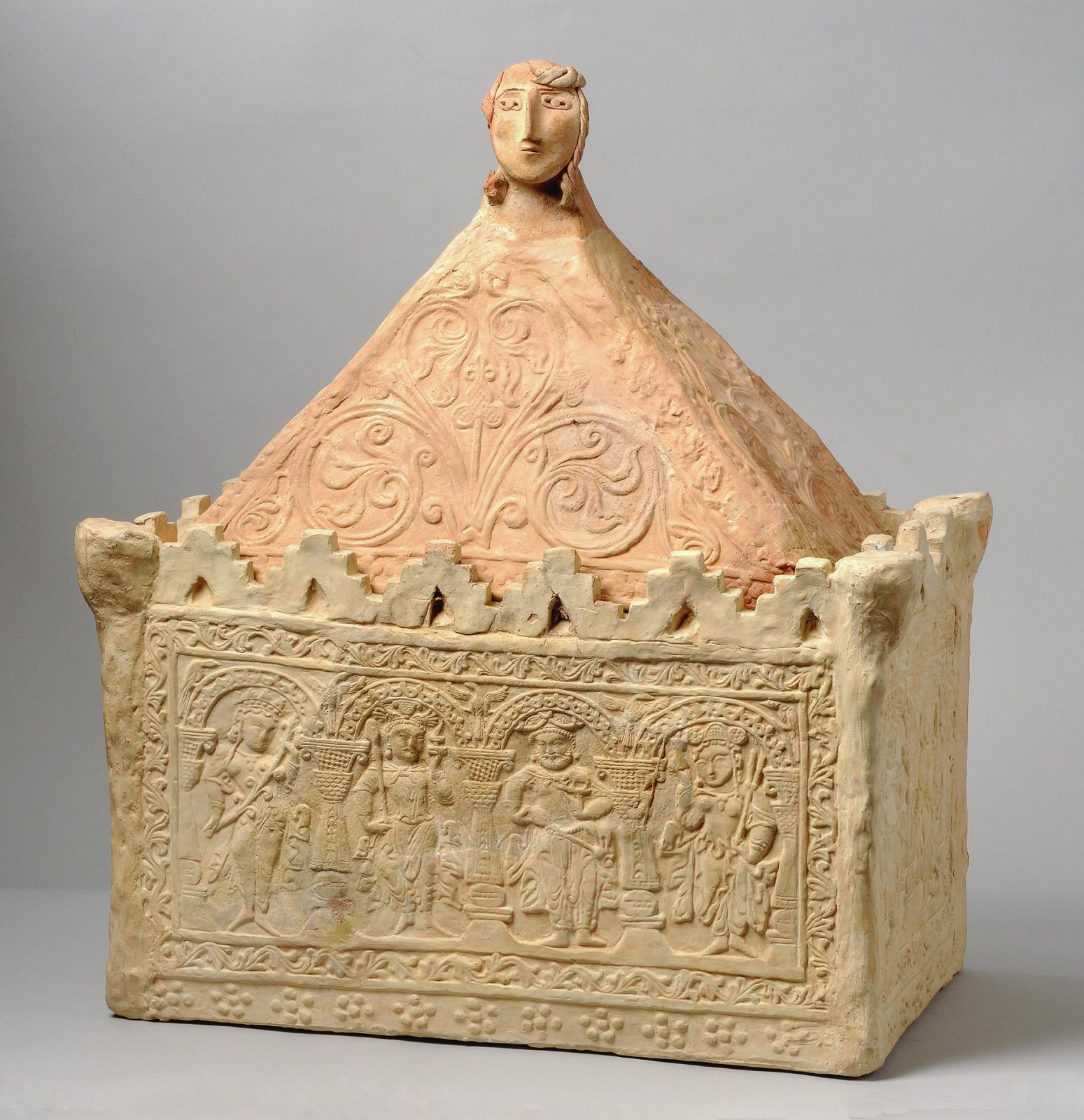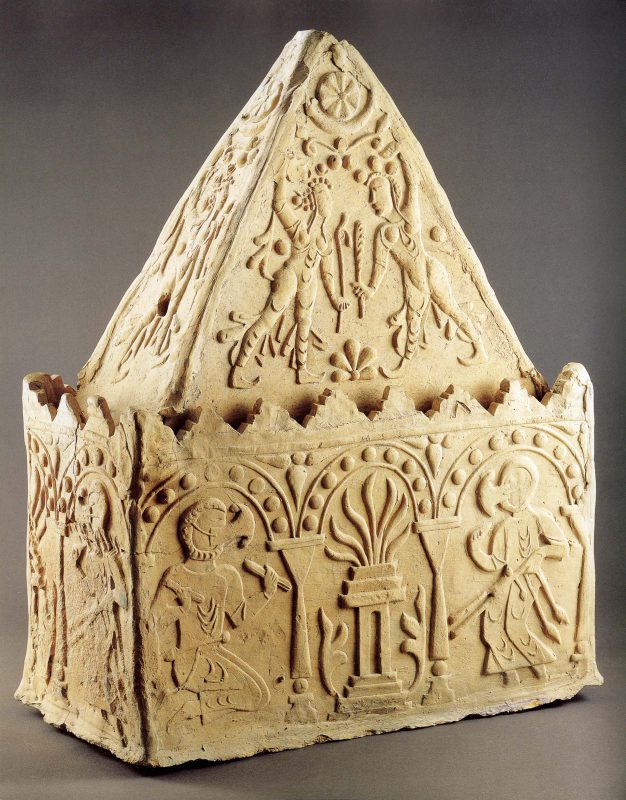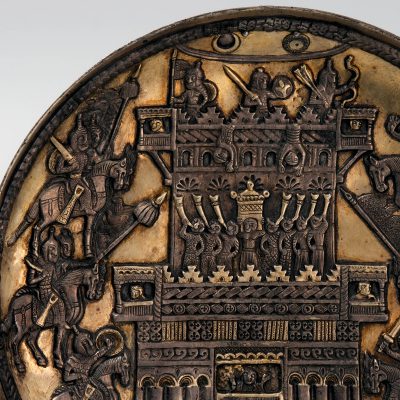
Durman Tepe Ossuary
Durman Tepe (Miankal, west of Samarkand, Uzbekistan) , Tepe 12, 7th–early 8th century CE
Baked clay; box: H. 22.5 × W. 51 × D. 31 cm; lid: H. 23 cm.
Museum of Oriental Art, Moscow, 624 КП IV [624 MP IV]–632 КП IV [632 MP IV].
Photograph © Museum of Oriental Art, Moscow.
Over 300 ossuaries (containers for bones)—some complete but most fragmentary—are now known from Sogdiana and neighboring regions of Chorasmia and Chach. Their varied shapes and decorations are specific to each region. This ossuary from Durman Tepe belongs to a group of similar style and stamped decoration that originated in the region northwest of Samarkand, where the Zerafshan River divides and then comes together again, creating the “island” of Miankal . Immediately to its south is the village of Biya-Nayman , where a number of similar ossuaries were found over a century ago.

Fig. 1 Ossuary. Mulla Kurgan (near Samarkand, Uzbekistan), ca. 7th century. Baked clay; 52 × 28 × 69 cm. Samarkand State Museum of History, Art and Architecture.
After Sarah Stewart, ed., The Everlasting Flame: Zoroastrianism in History and Imagination (London and New York: I. B. Tauris, 2013), 100, pl. 36.
These containers are rectangular in shape, their upper edges crenelated (having regular, square indentations) with stepped merlons (the solid parts between the indentations) in the manner of the Mulla Kurgan ossuary; Fig. 1. Their four sides are stamped with crowned male and female figures, each standing, and each wearing distinctive dress and holding one or two identifying attributes. Artisans seem to have taken great care to distinguish one figure from another, and thus we may assume that each represents a particular divinity. Certainly, the ancient Sogdians who ordered these ossuaries knew their identities by their appearance and attributes, but for us this represents a considerable challenge. Indeed, their identities have generated much debate among some of the leading scholars in the field, who dispute not only who the figures are, but the actual number of unique deities there might be as well.
However, it seems most likely that there are six in all—three female and three male—the minor distinctions among some of them probably due to small variations in the molds in which the figures were made. According to Frantz Grenet, these beings may be the six Zoroastrian Amesha Spentas, or “beneficent immortals,” whom the supreme being Ahura Mazda (himself a seventh Amesh Spenta) sired to aid him in overcoming evil. These guard Ahura Mazda’s creations, especially the “righteous” man, cattle, fire, metals, earth, water, and plants. Thus, of the four figures featured on the front of the ossuary, the female and male from the left may respectively be identified as Amurdad, patron of the plant kingdom, who holds a long vegetal spray with both her hands, and Atar, the fire god, who holds a fire-altar in his raised left hand and a shovel against his right shoulder.
The use of an arcade to frame individual figures recalls Byzantine metalwork on which the figures of saints appear under arcades. The influence of Byzantium here is certainly likely, since the two regions shared trade and diplomatic relations during the period, and some Sogdian metalworkSogdian Metalworking Learn more about Sogdian metalwork shows Byzantine influence. However, we should also remark that such figures placed under arches also appear in the art of Gandhara , an ancient kingdom spread between what is now Pakistan and Afghanistan, on Buddhist reliquaries from as early as the 1st and 2nd centuries.
As a particularly workable medium, clay lends itself to easy molding before firing. A master craftsman presumably created the original molds (or matrices) that were used to produce the decorative plaques that were then assembled to form the ossuary. This process could be repeated a great number of times. As a mold wore out and lost its details from too many impressions, it would be replaced by impressing another slab of clay onto the original matrix. Thus, a refreshed image, similar to the original mold, could be used for additional ossuaries. In this process, other craftsmen could introduce changes as well as new elements to the molds, thereby creating variations on the original designs. This way, ossuary designs evolved in sets or series of replications, much as those seen in coins. These small changes can be seen by comparing the decorated facets of this piece with fragments of other ossuaries found in Biya-Nayman ; Fig. 2.
In a comparison of the Biya-Nayman and the Durman Tepe ossuaries, both feature sets of standing figures within arcades, but their dress and attributes vary, as do the decorations of the arches above their heads. The elements set between the arches also differ (with the trefoils of Biya-Nayman reinterpreted as birds with outspread wings on the Durman Tepe container), as well as the friezes framing the whole composition. The sides of the Durman Tepe ossuary are stamped using a half-section of the mold that was used on the long side—another indication of the manufacturing process.
by Julie Bellemare and Judith A. Lerner
Boris I. Marshak [Marschak/Maršak], “On the Iconography of the Ossuaries from Biya-Naiman,” Silk Road Art and Archaeology 4 (1995 [1996]), 299–321.
As Michael Shenkar writes, “The interpretation of the figures decorating these two groups of closely related ossuaries poses one of the most complex problems in Sogdian iconography.” See Michael Shenkar, Intangible Sprits and Graven Images: The Iconography of Deities in the Pre-Islamic Iranian World, series Magical and Religious Literature of Late Antiquity, vol. 4 (Leiden and Boston: Brill, 2014), 170.
Michael Shenkar noted that the number of identities proposed for the figures has ranged from eight to thirteen different deities; see Michael Shenkar, Intangible Sprits and Graven Images: The Iconography of Deities in the Pre-Islamic Iranian World, series Magical and Religious Literature of Late Antiquity, vol. 4 (Leiden and Boston: Brill, 2014), 171. Frantz Grenet suggested six; see Frantz Grenet, “L’art zoroastrien en Sogdiane: Études d’iconographie funéraire,” Mesopotamia 21 (1986): 110. Shenkar, however, reasoned that what appear to be different crowns and attributes might only be variations in the rendering of a particular deity.
See Marlia Mundell Mango, “Byzantine, Sasanian and Central Asian Silver,” in Kontakte zwischen Iran, Byzanz und der Steppe in 6.–7. Jh., ed. Csanád Bálint (Budapest: <Academiae Scientiarum Hungaricae, 2000), 267–84.
The arcade composition ultimately derives from Roman sarcophagi. Tigran Mkrtychev and Aleksandr Naimark point out that, in borrowing the format, the Sogdians simply changed the attributes of the figures to fit their own gods. See Tigran K. Mkrtychev and Aleksandr I. Naimark [Naymark], “Ossuary,” in Culture and Art of Ancient Uzbekistan: Exhibition Catalogue, ed. Kazim A. Abdullaev, Edvard V. Rtveladze, and G. V. Shishkina (Moscow: Institute of Archeology of the USSR, Academy of Sciences, 1991), 65.




